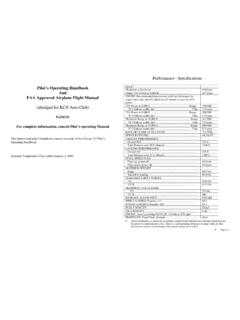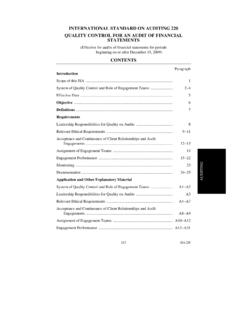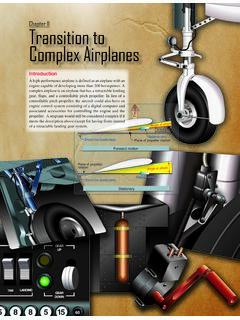Transcription of Aeronca 7AC Pilot Operating Handbook
1 Aeronca 7AC Pilot Operating Handbook N1946E SN 7AC-5513 2010 Covenant Aviation Pilot Operating Handbook , Champ 7AC 1-2 Covenant Aviation SN 7AC-5513 N1946E Created on 5/14/2010 4:09:00 PM 1-3 Aeronca 7AC Champion Pilot Operating Handbook N1946E SN7AC-5513 THIS Handbook INCLUDES THE MATERIAL REQUIRED TO BE FURNISHED TO THE Pilot BY FEDERAL AIR REGULATIONS AND ADDITIONAL INFORMATION PROVIDED BY THE MANUFACTURER. This Handbook meets GAMA Specification No. 1, SPECIFICATION FOR PILOTS Operating Handbook , dated February 15, 1975 with rev 2, issued October 18, 1996. It has been compiled from information in the Service Manual 7A Aeronca Champion, published by WAG-Aero in 1946 and USAF Flight Handbook for the USAF Series L-16A and L-16B published in 1948 and revised in 1953.
2 While writing this to comply with GAMA Spec 1 (which did not exist when this aircraft was manufactured and extant manuals were published), some of the quaint verbiage of these two manuals has been retained for your entertainment and edification. 2010 Covenant Aviation 821 Lake Stone Dr Monroe, NC 28112 Pilot Operating Handbook , Champ 7AC 1-4 Covenant Aviation SN 7AC-5513 N1946E Created on 5/14/2010 4:09:00 PM 1-5 1 GENERAL 1-1 2 LIMITATIONS 2-1 Airspeed Limitations 2-1 Propeller Limits 2-1 Static 2-1 Diameter 2-1 3 EMERGENCY PROCEDURES 3-1 Engine Runs Rough 3-1 Engine Failure Immediately After Takeoff 3-1 Engine Failure During Flight 3-1 Low Oil Pressure 3-1 Spin Recovery 3-1 Engine Fire 3-1 Ditching 3-2 Inadvertent Flight into Clouds 3-2 Night Flight 3-2 4 NORMAL PROCEDURES 4-1 Operating Checklists 4-1 Preflight Walkaround 4-1 Controls 4-1 Right Wing 4-1 Aileron 4-1 Struts 4-1 Landing Gear 4-2 Windshield 4-2 Engine and Nose 4-2 Propeller 4-2 Left Wing 4-2 Right Fuselage 4-2 Elevator 4-2 Rudder 4-3 Tailwheel 4-3 Left Fuselage 4-3 Pre-Takeoff: CIGARS-T 4-3 Pre-Landing.
3 CIGUMPS 4-3 Post Landing 4-3 Shutdown 4-3 Normal Takeoff 4-4 Normal Landing 4-4 Cold Weather Preflight 4-4 Fabric and Plexiglass Surfaces 4-4 Control Surfaces 4-5 Landing Gear 4-5 Engine Preheat 4-5 Pilot Operating Handbook , Champ 7AC 1-6 Covenant Aviation 5 PERFORMANCE 5-1 Performance Speeds 5-1 Power off Stalling Speeds 5-1 Range 5-1 Runway Lengths 5-2 Takeoff 5-2 Landing 5-2 6 WEIGHT AND BALANCE 6-1 Weight and Balance Worksheet 6-1 Center of Gravity Limits 6-2 General Weight Limits 6-2 Baggage Compartment Limits 6-2 7 AIRPLANE AND SYSTEMS 7-1 Dimensions 7-1 Engine 7-1 General 7-1 Oil 7-2 Carburetor 7-2 Fuel 7-2 Ignition 7-2 Magnetos and Spark Plugs 7-2 Firing Order 7-2 Spark Advance 7-2 Heat Control 7-2 Carburetor Heater 7-2 Fuel System 7-3 General 7-3 Gascolator Filter Assembly 7-3 Primer 7-3 Landing Gear 7-3 8 HANDLING, SERVICING, AND MAINTENANCE 8-1 Taxiing 8-1 Takeoff 8-1 Landing 8-3 Maneuvers 8-5 9 SUPPLEMENTS 9-1 Handstarting an Airplane 9-1 First.
4 Some basic concepts 9-1 Handstarting with Pilot /Ground Crew 9-1 SN 7AC-5513 N1946E Created on 5/14/2010 4:09:00 PM 1-7 Solo Handstarting 9-3 10 SAFETY AND OPERATIONAL TIPS 10-1 SN 7AC-5513 N1946E Created on 5/14/2010 4:09:00 PM 1-1 1 General The Aeronca Champion Is a two place, tandem, high wing monoplane. Basic construction consists of welded tube, fabric covered fuselage. Wings are fabric covered, wood spar with hydro-formed aluminum alloy ribs. Power is supplied by a 65 horsepower engine turning a fixed pitch wood propeller. The engine is installed against excessive vibration with rubber bushings at the motor mount attachment points, resulting in smooth, noise-free operation. Unrestricted vision is attained through the use of a one-piece molded windshield, large door windows and rear side windows.
5 Cabin control cables are concealed adding to the comfort of the spacious cabin. Engine controls are readily accessible from the front and rear seats. A spacious baggage compartment is located aft of the rear seat to accommodate luggage, guns, fishing equipment, and many other items. Basically, the Aeronca Champion is a conventional three control aircraft. The newly designed control system provides smooth non- fatiguing, positive control action. Brake pedals are provided for both front and rear occupants. A trim tab on the left elevator compensates for load differences and provides hands-off flight. Positive trim tab control is conveniently located above and between each occupant. The Aeronca oleo landing gear is incorporated in the Champion. This landing gear construction Insures sturdy yet smooth handling on rough fields.
6 Much of the shock is absorbed in the oleo thereby lessening fatigue on the rest of the airframe and wing structure. Ease in ground handling is assured with steerable leaf spring tail wheel and positive acting mechanical brakes. Tie down rings are incorporated at the strut wing point. SN 7AC-5513 N1946E Created on 5/14/2010 4:09:00 PM 2-1 2 Limitations Airspeed Limitations Vs -- Clean Stall 38 mph Vx Best Angle of Climb 50 mph Vy Best Rate of Climb 60 mph Vg -- Best Glide 60 mph Va -- Maneuvering Speed 95 mph Vne -- Never Exceed 129 mph Propeller Limits Static Full throttle setting not more than 2200 , not less than 2010 Diameter Not more than 72 inches. Not less than 70 inches. SN 7AC-5513 N1946E Created on 5/14/2010 4:09:00 PM 3-1 3 Emergency Procedures Engine Runs Rough Pull Carburetor full ON.
7 If the roughness is caused by carburetor ice, roughness will probably increase momentarily, then the engine should begin to run smoothly. If applying carburetor heat does not smooth the engine, check mags. It is possible a fouled plug, worn plug wire, or faulty mag is causing the roughness, in which cases switching to the good mag, while resulting in a slight loss of power, will smooth the engine. Land as soon as practical. Engine Failure Immediately After Takeoff Lower nose immediately to maintain Vg (60 MPH), land straight ahead. Engine Failure During Flight Establish a normal glide and go to your field. Depending on load, full nose-up trim will usually provide an airspeed just above Vg (60 MPH). Carb Heat ON Check mags. Check fuel. Low Oil Pressure If oil pressure goes under 30 pounds and oil temperature begins to climb, land as soon as possible.
8 Spin Recovery If the airplane enters an unintentional spin, immediately apply full rudder opposite direction of rotation; simultaneously bring the stick forward and bring throttle to idle. As rotation stops, return rudder to neutral and gently but firmly recover from the resulting dive. Engine Fire Fuel OFF. DIVE in an attempt to blow out fire. Land as quickly as possible. Pilot Operating Handbook , Champ 7AC 3-2 Covenant Aviation Ditching Landing in water will probably put this airplane on its back. Stalling immediately before contact with the surface will mitigate that likelihood. If it is absolutely necessary to land in the water, land upwind if on a lake, downstream if in a river. On lakes, waves are always perpendicular to wind, and streaks are always parallel to the wind. Inadvertent Flight into Clouds DO NOT enter clouds in this airplane.
9 However, in the event of inadvertent entry into cloud, one of two options may prevent loss of control of the airplane: 1. If the Pilot is instrument certified, an immediate 180 back to VFR may be possible. Standard Rate Turn with this needle is indicated by the right edge of the needle touching the left edge of the index, or the left edge of the needle touching the right edge of the index. Check time, roll gently into a standard rate for one minute, then roll out. 2. If the Pilot is NOT instrument certified, attempting the above procedure will almost certainly result in loss of control of the aircraft and subsequent inflight structural failure. Therefore, if the Pilot is not instrument certified, the only option is to TURN LOOSE OF THE STICK. Maintain heading by reference to the compass with very light rudder inputs; very, very gently ease back on the throttle a few hundred rpm to establish a gentle descent to VFR under the clouds.
10 Night Flight Because this aircraft has no electrical system and, therefore, no lights, night flight is prohibited. Any circumstance such as unexpected headwinds that result in flight after sundown constitutes an emergency requiring landing as soon as possible at the nearest lighted airfield. SN 7AC-5513 N1946E Created on 5/14/2010 4:09:00 PM 4-1 4 Normal Procedures Operating Checklists Preflight Walkaround Controls Controls free Radio, Intercom -OFF Magnetos -OFF Fuel -ON Visual check of instruments Fuel tank and hoses Brakes Rudder pedal cables Seat belts Right Wing Wing root fairing Step back and check the top of the wing for rips or tear in the fabric, or any other abnormality (ice, dirt, etc.) Trailing edge Aileron Check the four attachment points Ensure all nuts, bolts and cotter pins are in place and in good shape Aileron control Check nuts, bolts and cotter pins both above and below the wing Check for movement Wing tip Wing movement -grasp the wing tip and move the wing fore-aft and up-down, ensure there is no unusual movement, watch the landing gear Struts Bolts and lock nuts are in place Attachment to the wing, cross members, fuselage Leading edge Pilot Operating Handbook , Champ 7AC 4-2 Covenant Aviation Check pitot/static tube Landing Gear Bolts, nuts, tires, and brake cables Check strut to wheel cable Check fabric for damage Windshield Check for Cleanliness.








